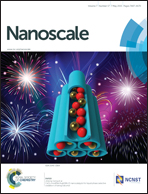Graphene and hydroxyapatite self-assemble into homogeneous, free standing nanocomposite hydrogels for bone tissue engineering†
Abstract
Graphene-nanoparticle (NP) composites have shown potential in applications ranging from batteries to, more recently, tissue engineering. Graphene and NPs should be integrated into uniform free-standing structures for best results. However, to date, this has been achieved only in few examples; in most cases, graphene/NP powders lacking three-dimensional (3D) structure were produced. Here we report a facile and universal method that can be used to synthesize such structures based on colloidal chemistry. We start from aqueous suspensions of both graphene oxide nanosheets and citrate-stabilized hydroxyapatite (HA) NPs. Hydrothermal treatment of the mixtures of both suspensions reduces graphene oxide to graphene, and entraps colloidal HA NPs into the 3D graphene network thanks to a self-assembled graphite-like shell formed around it. Dialysis through this shell causes uniform NP deposition onto the graphene walls. The resulting graphene-HA gels are highly porous, strong, electrically conductive and biocompatible, making them promising scaffolds for bone tissue engineering. This method can be applied to produce a variety of free-standing 3D graphene-based nanocomposites with unprecedented homogeneity.


 Please wait while we load your content...
Please wait while we load your content...